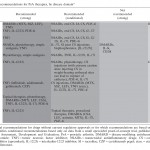A recent study of patients with psoriatic arthritis and cutaneous psoriasis found that these patients do not have a higher risk of worse outcomes after total hip arthroplasty compared with patients with osteoarthritis…


A recent study of patients with psoriatic arthritis and cutaneous psoriasis found that these patients do not have a higher risk of worse outcomes after total hip arthroplasty compared with patients with osteoarthritis…
Updated projections suggest that arthritis and arthritis-attributable activity limitation will remain large and growing problems for clinical and public health systems, which must plan and create policies and resources to address these future needs. By 2040, the number of U.S. adults with doctor-diagnosed arthritis is projected to increase 49% to 78.4 million. Can the healthcare system accommodate these projected increases? Not without changes. By 2025, the expected demand for rheumatologists is expected to exceed supply by 2,576 adult and 33 pediatric rheumatologists…
A variety of immune and nonimmune pathophysiologic mechanisms causing the disruption of alveolar capillaries with bleeding into the alveolar spaces can lead to diffuse alveolar hemorrhage (DAH). Immune-mediated mechanisms can cause DAH with or without the presence of capillaritis. The antineutrophil cytoplasmic antibody (ANCA)–associated vasculitis (AAV) syndromes—granulomatosis with polyangiitis (GPA) and microscopic polyangiitis (MPA)—are the…

A recent editorial in Arthritis & Rheumatology explored the role of sensitization, not nociception, as a key mechanism of pain for patients with knee OA, as well as inflammation’s role in pain perception. Recent research of synovitis and joint effusion supports the idea that early prevention or treatment of sensitization may be paramount to reducing long-term pain in patients with knee OA…

A recent review in Arthritis & Rheumatology examined advances in addressing the pathophysiology, genetics and treatment of enthesitis for patients with spondyloarthritis. And author Michael Weisman, MD, notes that challenges remain in understanding the genetics and triggers of enthesitis…

In February, new recommendations were released for the treatment of ankylosing spondylitis and nonradiographic axial spondyloarthritis, noting that NSAIDs may be the best initial treatment for the diseases, with TNF inhibitors as second-line therapies. The guideline was the result of a joint effort by the ACR, the Spondylitis Association of America and the Spondyloarthritis Research and Treatment Network…

Psoriatic arthritis (PsA) is remarkably diverse in presentation and course. To assist clinicians in its management, the Group for Research and Assessment of Psoriasis and Psoriatic Arthritis (GRAPPA) published treatment recommendations in 2009 based on a systematic evidence review. To be clinically relevant, such recommendations must be dynamic, and significant developments in PsA pathophysiology and disease assessment, particularly regarding the important contribution of comorbidities coupled with major therapeutic advances, necessitated an update of the GRAPPA recommendations…
Transitions in medical care can be high-risk periods due to the loss of continuity in care and worsening of medical conditions. Approximately one-quarter of the estimated 18 million adolescents aged 18–21 years in the U.S. have chronic conditions, including rheumatic diseases. Interventions in rheumatology practice can improve transition processes. Transition-readiness assessment tools and transition-satisfaction scales are available for use in rheumatology transition processes…
Although research regarding the increased cardiovascular (CV) morbidity and mortality in rheumatoid arthritis (RA) has burgeoned in recent years, the need remains for a better understanding of the effects of widely used DMARDs on CV risk and risk factors in RA patients. These authors set out to evaluate the long-term changes in cholesterol levels in patients with early RA. Decreases in RA disease activity over long-term follow-up were associated with increases in cholesterol levels in patients with early RA treated with either biologic or nonbiologic therapies…
Enthesitis is a central feature of spondyloarthritis (SpA). This review article summarizes the substantial progress that has been made in addressing the pathophysiology, molecular mechanisms, genetic associations, clinical features, diagnostic modalities and treatment of enthesitis. Further examination into the role of the inflammatory mediators, including IL-17, IL-22, and IL-23 as well as potentially others, in driving enthesitis and bone formation will be important to direct our attention toward future therapeutic targeted pathways in patients with SpA…